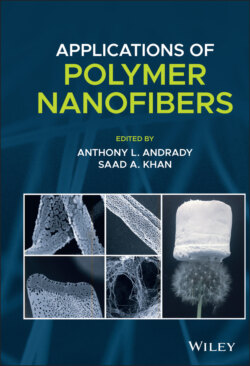Читать книгу Applications of Polymer Nanofibers - Группа авторов - Страница 43
2.4 Fabrication of Nanofiber Fabrics
ОглавлениеConventional fabrics are usually categorized as nonwoven, woven, knitting, and braiding types. However, fabrics made of nanofibers are mainly in nonwoven forms, and only a few of them are in woven forms (Wang et al. 2016; Deitzel et al. 2001; Kwon and Matsuda 2005; An et al. 2016; Bagherzadeh et al. 2011; Brugo and Palazzetti 2016; Gorjanc et al. 2009; Han et al. 2014, 2006; Kanafchian et al. 2011; Laforgue 2011; Lee and Obendorf 2007a,b; Liu et al. 2013; Park et al. 2013; Qin and Xin 2010; Zhu et al. 2016; Shang et al. 2010; Shao et al. 2016; Su et al. 2014; Sun et al. 2015; Tsai 2005; Wakamatsu et al. 2006; Yokoyama et al. 2009; Zhao et al. 2017).
Nanofiber‐based nonwovens can be made from randomly arranged nanofiber fabrics and bonded by mechanical forces, chemical forces, or self‐adhesion. While, as to woven fabrics, it needs to prepare nanofiber yarns first, then interweave to shape up. Traditionally, woven fabrics are made from interlacing a set of warp and a set of weft yarns by a weaving machine, which requires the yarns having desired strength and abrasive resistance. In most cases, the mechanical properties of nanofiber yarns cannot meet this demand. It is, therefore, concluded that producing nanofiber woven fabrics are much more complicated compared to nonwoven ones.
